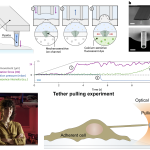
CNR-INO at the awards ceremony of the “Viva Marga” competition
May 27, 2024
A Novel Tool for Deciphering Cell Mechanosensing
May 31, 2024Research on the supersolid is progressing, the new phase of matter halfway between the crystalline and superfluid states, observed for the first time in 2019 in Pisa in an ultracold gas of magnetic atoms by a research group from the University of Florence and the National Institute of Optics of the National Research Council (Cnr-Ino).
A new publication in Nature, again by the same research team, investigates how supersolids – which follow the laws of quantum mechanics – differ from crystals and, on the other hand, from superfluids. The Tuscan group faced and solved the problem by measuring for the first time a quantity, the “superfluid fraction” which exactly characterizes the properties of the supersolid, i.e. how much it behaves like a solid and how much like a superfluid.
“The measurement technique of the superfluid fraction – explain the coordinators Giovanni Modugno, professor of Matter Physics at the University of Florence and associated with Cnr Ino, and Augusto Smerzi, research director at Cnr Ino, both also belonging to the European Laboratory of Non-linear Spectroscopy (LENS) – is based on the phenomenon of Josephson oscillations, named after the physicist Brian Josephson, Nobel Prize winner for physics in 1973. When two superfluids are separated by a barrier, for example a potential given by a laser beam, they can still exchange particles with each other, unlike what happens with two normal fluids. This is a phenomenon of quantum mechanics and is called the quantum tunneling effect. The number of particles in the two superfluids thus tends to oscillate over time.”
In the supersolid, this passage of particles occurs in the absence of barriers imposed from the outside, precisely because by its nature partially crystalline structures are formed, which constitute a sort of spontaneous barriers. The research group appropriately excited the system with a laser to initiate particle transfer, observing the existence of stable Josephson oscillations over time. The group then discovered that the frequency of the Josephson oscillations is determined precisely by the superfluid fraction, i.e. the system’s ability to exchange particles, and therefore allows a direct measurement.
“The result obtained – the researchers continue – is important because it links the perhaps somewhat abstract concept of superfluid fraction to the possibility for particles to move from one density peak to another. This possibility is present neither for ordinary superfluids, which have no density peaks, nor for crystals, in which the particles are locked into the density peaks. Spontaneous Josephson oscillations are therefore a unique characteristic of supersolids.”
The superfluid fraction was theoretically proposed more than 50 years ago by Antony Leggett, Nobel Prize winner for physics in 2003, but never measured in a supersolid until now. The superfluid fraction can vary from 1 (ordinary superfluid) up to 0 (classical solid), taking intermediate values for a supersolid. In the Pisa experiment, the researchers demonstrated that they could control the superfluid fraction throughout the range from 0 to 1, increasing or decreasing the depth of the crystalline lattice that forms the supersolid.
“The measurement of the superfluid fraction of a supersolid – conclude the researchers – opens the door to the investigation of numerous particular properties that differentiate supersolids from superfluids. Furthermore, the innovative measurement technique based on the Josephson effect can be applied to other physical systems candidate to host supersolid phases, even in complex and macroscopic materials such as superconductors and liquid helium, allowing us to broaden the knowledge and possible applications of this new phase of matter”.
More information at this link





